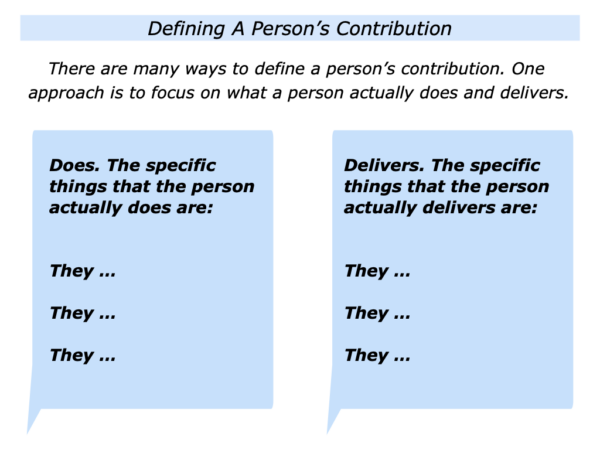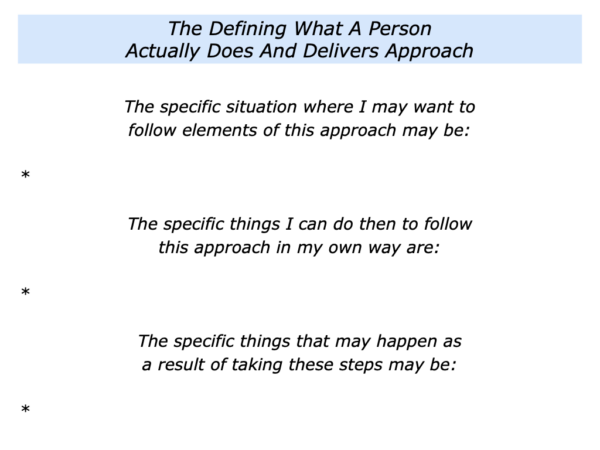
There are many ways to define a person’s contribution. One approach is to focus on what the person actually does and delivers. It is to focus on these things rather than what a person says they do.
Let’s explore how this approach can be translated into action. Imagine that you aim fill a specific position in a company.
The first step will be to define the specific results – the outcomes – you want a person to deliver in the role. The next step will be to find a person who is likely to deliver these results
Whilst the role may be advertised externally, imagine that you want to begin by focusing on two internal applicants. When looking at each person, you can aim:
To clarify what a person actually does and delivers in their work;
To clarify whether a person has the attitude and ability required to deliver the desired results in the role.
If you are looking externally, it will also be vital to do similar extensive research when considering applicants. This may take time and also involve inviting a person to do certain kinds of prework.
The following section describes how you can apply this approach when looking at two people you know. It describes what may be extreme examples. But you will obviously apply your own observations when considering each person’s previous and present work.
Imagine that you are looking at Person A and Person B. Below may be some of the things that they do and deliver. (Again, these may be extreme examples, but you will obviously have your own examples when looking at individuals.)
Person A
Does. The specific things that
the person actually does are:
They have a positive attitude and encourage people. They make positive contributions to meetings. They are good at providing possible suggestions to tackling challenges.
They are proactive, think ahead and make clear working contracts with people. They keep their key stakeholders informed about what is happening. They think strategically about what is good for the company.
They help to create a good atmosphere in the office. They are upbeat but thoughtful when it comes to managing challenges. They are also prepared to tackle difficult people issues and find solutions.
Delivers. The specific things that
the person actually delivers are:
They achieve their performance targets. They are good with customers and deliver high levels of customer satisfaction. This often leads to getting repeat business.
They have acted as good mentors for new joiners. They taught these people about the Dos and Don’t for making their best contributions to the company. They have also led several excellent modules on our academy for new managers.
They have a track record of leading successful project teams. They have led teams that successfully launched two new products. They also led a team that successfully integrated a business that we had acquired.
Person B
Does. The specific things that
the person actually does are:
They tend to be theoretical in the way they speak. They are good at outlining concepts but find it hard to show how these can be applied in a concrete way.
They have a tendency to point out problems in the company and whilst only sometimes moving on to exploring solutions. This means that people stop listening to their views.
They often talk about their department’s issues – they lead a team of specialists – and the problems they face. They don’t seem to think strategically in terms of focusing on the company’s goals.
Delivers. The specific things that
the person actually delivers are:
They deliver good work within their specialist area of expertise. They sometimes need to be reminded, however, that it is important to focus on the whole company’s goals.
They deliver mixed morale scores in their department. This is partly because they lead a group of specialists who sometimes want to focus on their own agenda. But there are things they could to do improve the morale.
They deliver mixed results in terms of their department’s relationships with various stakeholders within the company. They sometimes talk about why things can’t be done rather than try to satisfy their internal customers.
Imagine that you have done such an exercise when looking at several candidates. You will then make a decision regarding the likelihood of a person having the attitude and ability required to deliver the desired results.
There are many models for defining a person’s past or potential contribution. One approach is to clarify what a person actually does and delivers. This is because their previous behaviour can be a good predictor to how they may behave in the future.
Let’s return to your own life and work. Looking ahead, can you think of a situation where you may want to follow elements of this approach? How can you follow this in your own way?
If you wish, try tackling the exercise on this theme. This invites you to complete the following sentences.



Leave a Reply